A Taper-in-Taper Structured Interferometric Optical Fiber Sensor for Cu2+ ion Detection
Abstract
:1. Introduction
2. Materials and Methods
2.1. Fabrication of the Taper-in-Taper Fiber Sensor
2.2. RI and Cu2+ Detection Experiments
2.3. Principle of the Developed Sensor
3. Results and Discussion
3.1. Sensitivity Study of Taper-in-Taper Fiber Sensor with Different Parameters
3.2. RI Testing Result of the Taper-in-Taper Fiber Sensor
3.3. Application in Cu2+ Detection
4. Conclusions
Author Contributions
Funding
Institutional Review Board Statement
Informed Consent Statement
Data Availability Statement
Acknowledgments
Conflicts of Interest
References
- Luo, W.; Cao, Z.; Zhang, G.; Liu, F.; Liu, B.; Du, W.; Han, Y.; Yu, B. A highly sensitive optical fiber temperature sensor based on the enhanced Vernier effect. Opt. Fiber Technol. 2021, 67, 102702. [Google Scholar] [CrossRef]
- Gong, P.; Li, X.; Zhou, X.; Zhang, Y.; Chen, N.; Wang, S.; Zhang, S.; Zhao, Y. Optical fiber sensors for glucose concentration measurement: A review. Opt. Laser Technol. 2021, 139, 106981. [Google Scholar] [CrossRef]
- He, C.; Korposh, S.; Correia, R.; Liu, L.; Hayes-Gill, B.R.; Morgan, S.P. Optical fibre sensor for simultaneous temperature and relative humidity measurement: Towards absolute humidity evaluation. Sens. Actuators B Chem. 2021, 344, 130154. [Google Scholar] [CrossRef]
- Wang, Y.-Y.; Zhang, F.-X.; Zhao, Q.-C.; Che, C.-R. Real-time monitoring of pressure and temperature of oil well using a carbon-coated and bellow-packaged optical fiber sensor. Opt. Fiber Technol. 2021, 67, 102703. [Google Scholar] [CrossRef]
- Ding, Z.; Sun, K.; Liu, K.; Jiang, J.; Yang, D.; Yu, Z.; Li, J.; Liu, T. Distributed refractive index sensing based on tapered fibers in optical frequency domain reflectometry. Opt. Express 2018, 26, 13042–13054. [Google Scholar] [CrossRef] [PubMed]
- Gao, H.; Zhang, Y.-X.; Zhang, W.-G.; Yan, T.-Y. High sensitivity optical fiber temperature sensor based on PDMS-filled with extended measuring range. Optik 2021, 248, 168181. [Google Scholar] [CrossRef]
- Lopez, J.D.; Keley, M.; Dante, A.; Werneck, M.M. Optical fiber sensor coated with copper and iron oxide nanoparticles for hydrogen sulfide sensing. Opt. Fiber Technol. 2021, 67, 102731. [Google Scholar] [CrossRef]
- Goossens, S.; Berghmans, F.; Sharif Khodaei, Z.; Lambinet, F.; Karachalios, E.; Saenz-Castillo, D.; Geernaert, T. Practicalities of BVID detection on aerospace-grade CFRP materials with optical fibre sensors. Compos. Struct. 2021, 259, 113243. [Google Scholar] [CrossRef]
- Chen, W.-H.; Dillon, W.D.N.; Armstrong, E.A.; Moratti, S.C.; McGraw, C.M. Self-referencing optical fiber pH sensor for marine microenvironments. Talanta 2021, 225, 121969. [Google Scholar] [CrossRef] [PubMed]
- Liu, C.; Su, W.Q.; Wang, F.M.; Li, X.L.; Yang, L.; Sun, T.; Mu, H.W.; Chu, P.K. Theoretical assessment of a highly sensitive photonic crystal fibre based on surface plasmon resonance sensor operating in the near-infrared wavelength. J. Mod. Opt. 2019, 66, 1–6. [Google Scholar] [CrossRef]
- Rifat, A.A.; Ahmed, R.; Yetisen, A.K.; Butt, H.; Sabouri, A.; Mandiraji, G.A.; Yun, S.H.; Adikan, F.R.M. Photonic crystal fiber based plasmonic sensors. Sens. Actuators B Chem. 2017, 243, 311–325. [Google Scholar] [CrossRef]
- Chiavaioli, F.; Baldini, F.; Tombelli, S.; Trono, C.; Giannetti, A. Biosensing with optical fiber gratings. Nanophotonics 2017, 6, 663–679. [Google Scholar] [CrossRef]
- Woyessa, G.; Nielsen, K.; Stefani, A.; Markos, C.; Bang, O. Temperature insensitive hysteresis free highly sensitive polymer optical fiber Bragg grating humidity sensor. Opt. Express 2016, 24, 1206–1213. [Google Scholar] [CrossRef] [PubMed] [Green Version]
- Coelho, L.; Viegas, D.; Santos, J.L.; de Almeida, J. Characterization of zinc oxide coated optical fiber long period gratings with improved refractive index sensing properties. Sens. Actuators B Chem. 2016, 223, 45–51. [Google Scholar] [CrossRef] [Green Version]
- Zhao, Y.H.; Liu, Y.Q.; Zhang, L.; Zhang, C.Y.; Wen, J.X.; Wang, T.Y. Mode converter based on the long-period fiber gratings written in the two-mode fiber. Opt. Express 2016, 24, 6186–6195. [Google Scholar] [CrossRef] [PubMed]
- Lou, J.; Wang, Y.; Tong, L. Microfiber optical sensors: A review. Sensors 2014, 14, 5823–5844. [Google Scholar] [CrossRef] [PubMed] [Green Version]
- Sun, L.P.; Huang, T.S.; Yuan, Z.H.; Liu, W.F.; Xiao, P.; Yang, M.J.; Ma, J.; Ran, Y.; Jin, L.; Li, J.; et al. Ultra-high sensitivity of dual dispersion turning point taper-based Mach-Zehnder interferometer. Opt. Express 2019, 27, 23103–23111. [Google Scholar] [CrossRef]
- Liu, J.H.; Cheng, M.H.; Kong, X.D.; Han, D.D.; Dong, J.; Luo, W.F.; Ren, K.L. Microtapered long period gratings: Non-destructive fabrication, highly sensitive torsion sensing, and tunable broadband filtering. Infrared Phys. Technol. 2019, 102, 7. [Google Scholar] [CrossRef]
- Wang, Y.; Zhu, G.; Li, M.; Singh, R.; Marques, C.; Min, R.; Kaushik, B.K.; Zhang, B.; Jha, R.; Kumar, S. Water Pollutants p-Cresol Detection Based on Au-ZnO Nanoparticles Modified Tapered Optical Fiber. IEEE Trans. Nano Biosci. 2021, 20, 377–384. [Google Scholar] [CrossRef]
- Taha, B.A.; Ali, N.; Sapiee, N.M.; Fadhel, M.M.; Yeh, R.M.M.; Bachok, N.N.; Al Mashhadany, Y.; Arsad, N. Comprehensive Review Tapered Optical Fiber Configurations for Sensing Application: Trend and Challenges. Biosensors 2021, 11, 253. [Google Scholar] [CrossRef] [PubMed]
- Vaiano, P.; Carotenuto, B.; Pisco, M.; Ricciardi, A.; Quero, G.; Consales, M.; Crescitelli, A.; Esposito, E.; Cusano, A. Lab on Fiber Technology for biological sensing applications. Laser Photonics Rev. 2016, 10, 922–961. [Google Scholar] [CrossRef]
- Guo, T. Fiber Grating-Assisted Surface Plasmon Resonance for Biochemical and Electrochemical Sensing. J. Lightwave Technol. 2017, 35, 3323–3333. [Google Scholar] [CrossRef]
- Chen, C.; Yang, R.; Zhang, X.-Y.; Wei, W.-H.; Guo, Q.; Zhang, X.; Qin, L.; Ning, Y.-Q.; Yu, Y.-S. Compact refractive index sensor based on an S-tapered fiber probe. Opt. Mater. Express 2018, 8, 919–925. [Google Scholar] [CrossRef]
- Xia, F.; Zhao, Y.; Peng, Y. In-line microfiber MZI operating at two sides of the dispersion turning point for ultrasensitive RI and temperature measurement. Sens. Actuators A Phys. 2020, 301, 111754. [Google Scholar] [CrossRef]
- Xia, F.; Zhao, Y. RI sensing system with high sensitivity and large measurement range using a microfiber MZI and a photonic crystal fiber MZI. Measurement 2020, 156, 107603. [Google Scholar] [CrossRef]
- Xia, F.; Zhao, Y.; Zheng, H.-K.; Li, L.-K.; Tong, R.-J. Ultra-sensitive seawater temperature sensor using an FBG-cascaded microfiber MZI operating at dispersion turning point. Opt. Laser Technol. 2020, 132, 106458. [Google Scholar] [CrossRef]
- Wu, S.; Cheng, H.; Ma, J.; Yang, X.; Wang, S.; Lu, P. Temperature-independent ultra-sensitive refractive index sensor based on hollow-core silica tubes and tapers. Opt. Express 2021, 29, 10939–10948. [Google Scholar] [CrossRef]
- Ma, J.W.; Cheng, H.H.; Yang, X.M.; Zhang, S.Y.; Li, Y.Q.; Wang, S.; Wu, S. Spectral Characteristics of Fiber-Based S-Shape Taper Refractometer with High Sensitivity. IEEE Photonics Technol. Lett. 2021, 33, 1266–1269. [Google Scholar] [CrossRef]
- Ma, Z.Y.; Zhang, Q.Q.; Chan, C.C. A Taper-in-Taper Fiber Optic Biosensor Based on Mach-Zehnder Interferometer for Human Sweat pH Detection. In Proceedings of the Global Intelligent Industry Conference, Guangzhou, China, 20–21 November 2020. [Google Scholar]
- Wang, Z.; Singh, R.; Marques, C.; Jha, R.; Zhang, B.; Kumar, S. Taper-in-taper fiber structure-based LSPR sensor for alanine aminotransferase detection. Opt. Express 2021, 29, 43793–43810. [Google Scholar] [CrossRef]
- Li, J.; Yang, Z.-l.; Ding, T.; Song, Y.-J.; Li, H.-C.; Li, D.-Q.; Chen, S.; Xu, F. The role of surface functional groups of pectin and pectin-based materials on the adsorption of heavy metal ions and dyes. Carbohydr. Polym. 2022, 276, 118789. [Google Scholar] [CrossRef]
- Guo, Y.; Sun, Y.; Li, Z.; Feng, S.; Yang, R.; Qu, L. Detection, detoxification, and removal of multiply heavy metal ions using a recyclable probe enabled by click and declick chemistry. J. Hazard. Mater. 2022, 423, 127242. [Google Scholar] [CrossRef] [PubMed]
- Zou, T.; Xing, X.; Yang, Y.; Wang, Z.; Wang, Z.; Zhao, R.; Zhang, X.; Wang, Y. Water-soluble ZnO quantum dots modified by (3-aminopropyl)triethoxysilane: The promising fluorescent probe for the selective detection of Cu2+ ion in drinking water. J. Alloys Compd. 2020, 825, 153904. [Google Scholar] [CrossRef]
- Sun, T.; Li, Y.; Niu, Q.; Li, T.; Liu, Y. Highly selective and sensitive determination of Cu2+ in drink and water samples based on a 1,8-diaminonaphthalene derived fluorescent sensor. Spectrochim. Acta Part A Mol. Biomol. Spectrosc. 2018, 195, 142–147. [Google Scholar] [CrossRef]
- Mahajan, P.G.; Dige, N.C.; Vanjare, B.D.; Eo, S.-H.; Kim, S.J.; Lee, K.H. A nano sensor for sensitive and selective detection of Cu2+ based on fluorescein: Cell imaging and drinking water analysis. Spectrochim. Acta Part A Mol. Biomol. Spectrosc. 2019, 216, 105–116. [Google Scholar] [CrossRef]
- Huangfu, C.; Zhang, Y.; Jang, M.; Feng, L. A μPAD for simultaneous monitoring of Cu2+, Fe2+ and free chlorine in drinking water. Sens. Actuators B Chem. 2019, 293, 350–356. [Google Scholar] [CrossRef]
- Perelonia, K.B.S.; Benitez, K.C.D.; Banicod, R.J.S.; Tadifa, G.C.; Cambia, F.D.; Montojo, U.M. Validation of an analytical method for the determination of cadmium, lead and mercury in fish and fishery resources by graphite furnace and Cold Vapor Atomic Absorption Spectrometry. Food Control 2021, 130, 108363. [Google Scholar] [CrossRef]
- Vyhnanovský, J.; Yildiz, D.; Štádlerová, B.; Musil, S. Efficient photochemical vapor generation of bismuth using a coiled Teflon reactor: Effect of metal sensitizers and analytical performance with flame-in-gas-shield atomizer and atomic fluorescence spectrometry. Microchem. J. 2021, 164, 105997. [Google Scholar] [CrossRef]
- Valizadeh, M.; Braki, Z.A.; Rashidi, R.; Maghfourian, M.; Shenas, A.T. Fuzzy inference system and adaptive neuro-fuzzy inference system approaches based on spectrophotometry method for the simultaneous determination of salmeterol and fluticasone in binary mixture of pharmaceutical formulation. Optik 2021, 244, 167592. [Google Scholar] [CrossRef]
- Zhou, W.-Y.; Sun, R.; Li, S.-S.; Guo, Y.; Shen, W.; Wang, J.; Deepak, F.L.; Li, Y.; Wang, Z. Engineering surface electron and active site at electrochemical sensing interface of CN vacancy-mediated Prussian blue analogue for analysis of heavy metal ions. Appl. Surf. Sci. 2021, 564, 150131. [Google Scholar] [CrossRef]
- Xu, T.; Hu, J.; Chen, H. Transition metal ion Co(II)-assisted photochemical vapor generation of thallium for its sensitive determination by inductively coupled plasma mass spectrometry. Microchem. J. 2019, 149, 103972. [Google Scholar] [CrossRef]
- Sung, T.-W.; Lo, Y.-L. Highly sensitive and selective sensor based on silica-coated CdSe/ZnS nanoparticles for Cu2+ ion detection. Sens. Actuators B Chem. 2012, 165, 119–125. [Google Scholar] [CrossRef]
- Huang, Q.; Zhu, W.J.; Wang, Y.; Deng, Z.; Li, Z.; Peng, J.K.; Lyu, D.J.; Lewis, E.; Yang, M.H. Optical fiber plasmonic sensor for the ultrasensitive detection of copper (II) ion based on trimetallic Au@AgPt core-shell nanospheres. Sens. Actuators B Chem. 2020, 321, 128480. [Google Scholar] [CrossRef]
- Tang, Y.; Zhang, Q.; Dong, X.; Chan, C.C. Optical Fiber Copper (II) ion Sensor Based on Long Period Fiber Grating. In Proceedings of the 2020 IEEE 5th Optoelectronics Global Conference (OGC), Shenzhen, China, 7–11 September 2020. [Google Scholar]
- Huang, Y.; Sun, J.; Wu, D.; Feng, X. Layer-by-layer self-assembled chitosan/PAA nanofiltration membranes. Sep. Purif. Technol. 2018, 207, 142–150. [Google Scholar] [CrossRef]
- Hou, L.T.; Zhang, X.D.; Yang, J.R.; Kang, J.; Ran, L.L. Simultaneous measurement of refractive index and temperature based on half-tapered SMS fiber structure with fringe-visibility difference demodulation method. Opt. Commun. 2019, 433, 252–255. [Google Scholar] [CrossRef]
- Bhardwaj, V.; Kishor, K.; Sharma, A.C. Tapered optical fiber geometries and sensing applications based on Mach-Zehnder Interferometer: A review. Opt. Fiber Technol. 2020, 58, 102302. [Google Scholar] [CrossRef]
- Wang, X.M.; Su, J.X.; Wang, Y.Y.; Yang, C.F.; Dai, S.X.; Zhang, P.Q. High-sensitivity sensing in bare Ge-Sb-Se chalcogenide tapered fiber with optimal structure parameters. J. Non-Cryst. Solids 2021, 559, 120686. [Google Scholar] [CrossRef]
- Liu, L.; Liu, Z.; Zhang, Y.; Liu, S. Side-Polished D-Type Fiber SPR Sensor for RI Sensing with Temperature Compensation. IEEE Sens. J. 2021, 21, 16621–16628. [Google Scholar] [CrossRef]
- Ahsani, V.; Ahmed, F.; Jun, M.B.G.; Bradley, C. Tapered Fiber-Optic Mach-Zehnder Interferometer for Ultra-High Sensitivity Measurement of Refractive Index. Sensors 2019, 19, 1652. [Google Scholar] [CrossRef] [Green Version]
- Kanmani, R.; Zainuddin, N.A.M.; Rusdi, M.F.M.; Harun, S.W.; Ahmed, K.; Amiri, I.S.; Zakaria, R. Effects of TiO2 on the performance of silver coated on side-polished optical fiber for alcohol sensing applications. Opt. Fiber Technol. 2019, 50, 183–187. [Google Scholar] [CrossRef]
- Ma, Y.; Yi, Y.; Li, X.; Su, C.; Zhang, M.; Geng, T.; Sun, W.; Yuan, L. Refractometer based on fiber Mach-Zehnder interferometer composed of two micro bending cores. Opt. Express 2021, 29, 31443–31454. [Google Scholar] [CrossRef]
- Zainuddin, N.H.; Chee, H.Y.; Ahmad, M.Z.; Mahdi, M.A.; Abu Bakar, M.H.; Yaacob, M.H. Sensitive Leptospira DNA detection using tapered optical fiber sensor. J. Biophotonics 2018, 11, 12. [Google Scholar] [CrossRef] [PubMed]
- Wang, X.; Tong, Z.R.; Zhang, W.H.; Xue, L.F. Research on dual-parameter optical fiber sensor based on few-mode fiber with two down-tapers. Opt. Eng. 2017, 56, 6. [Google Scholar] [CrossRef]

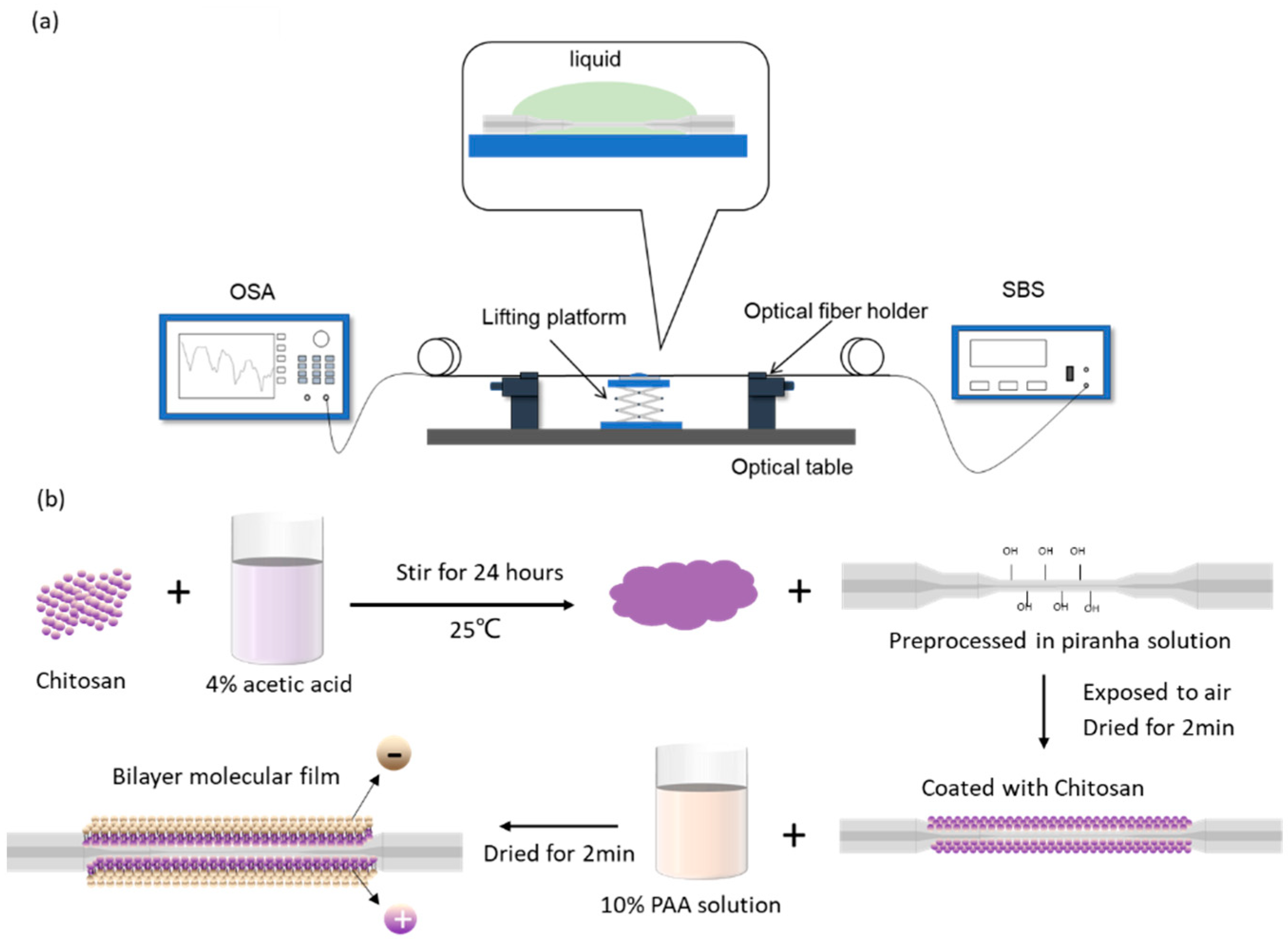
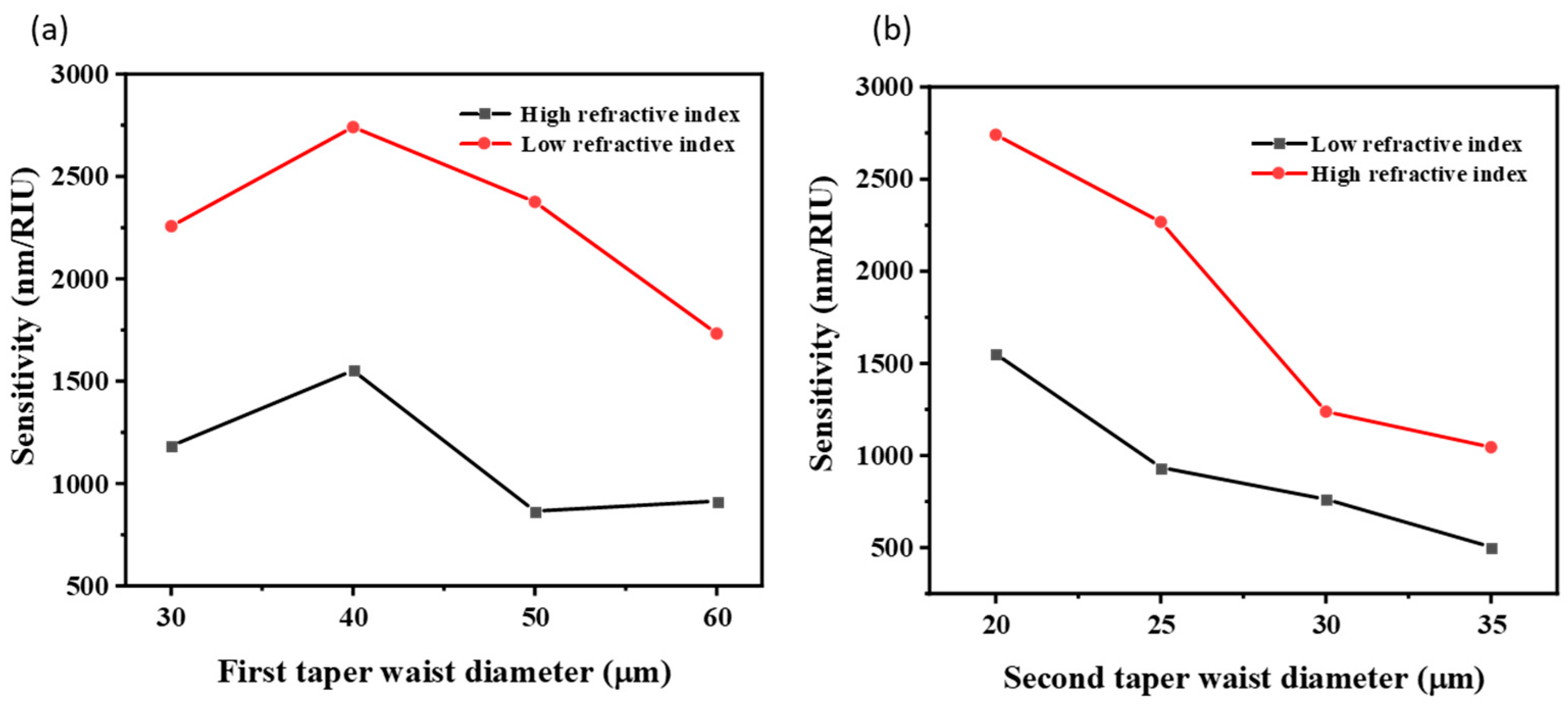


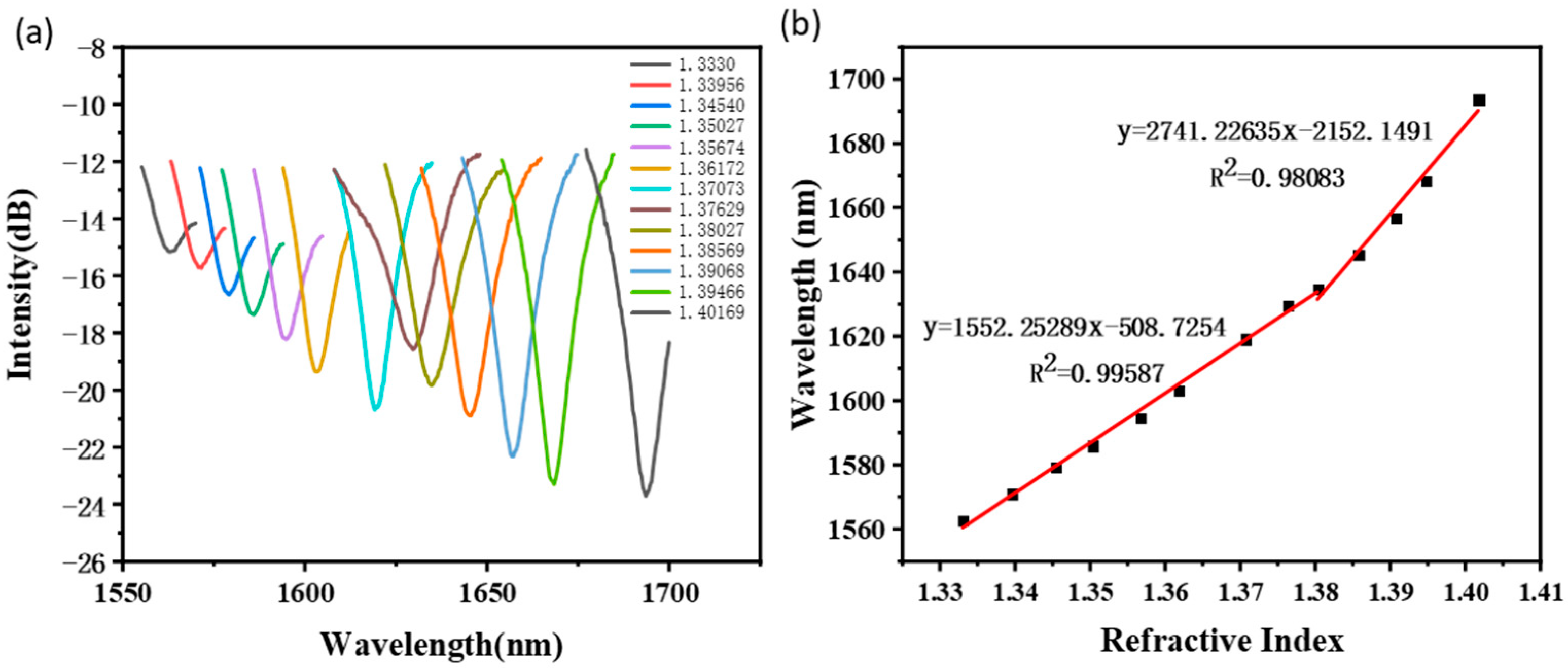
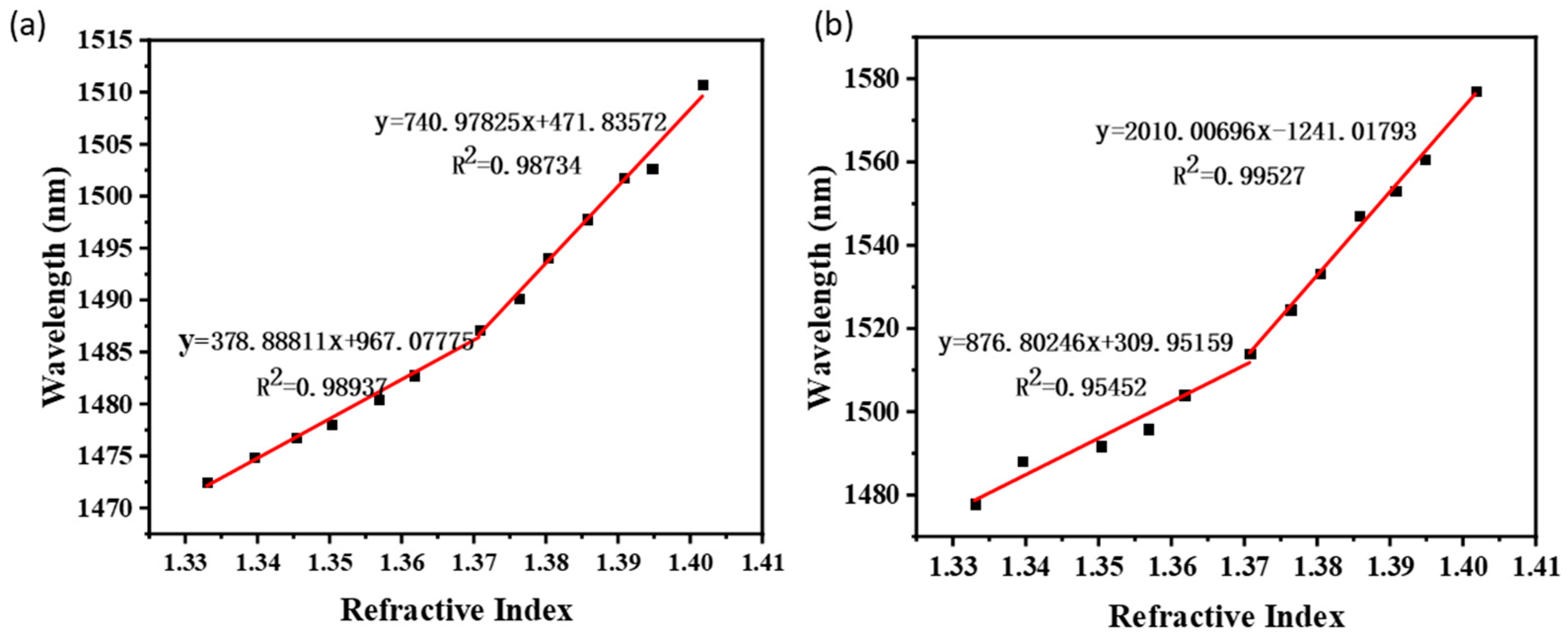

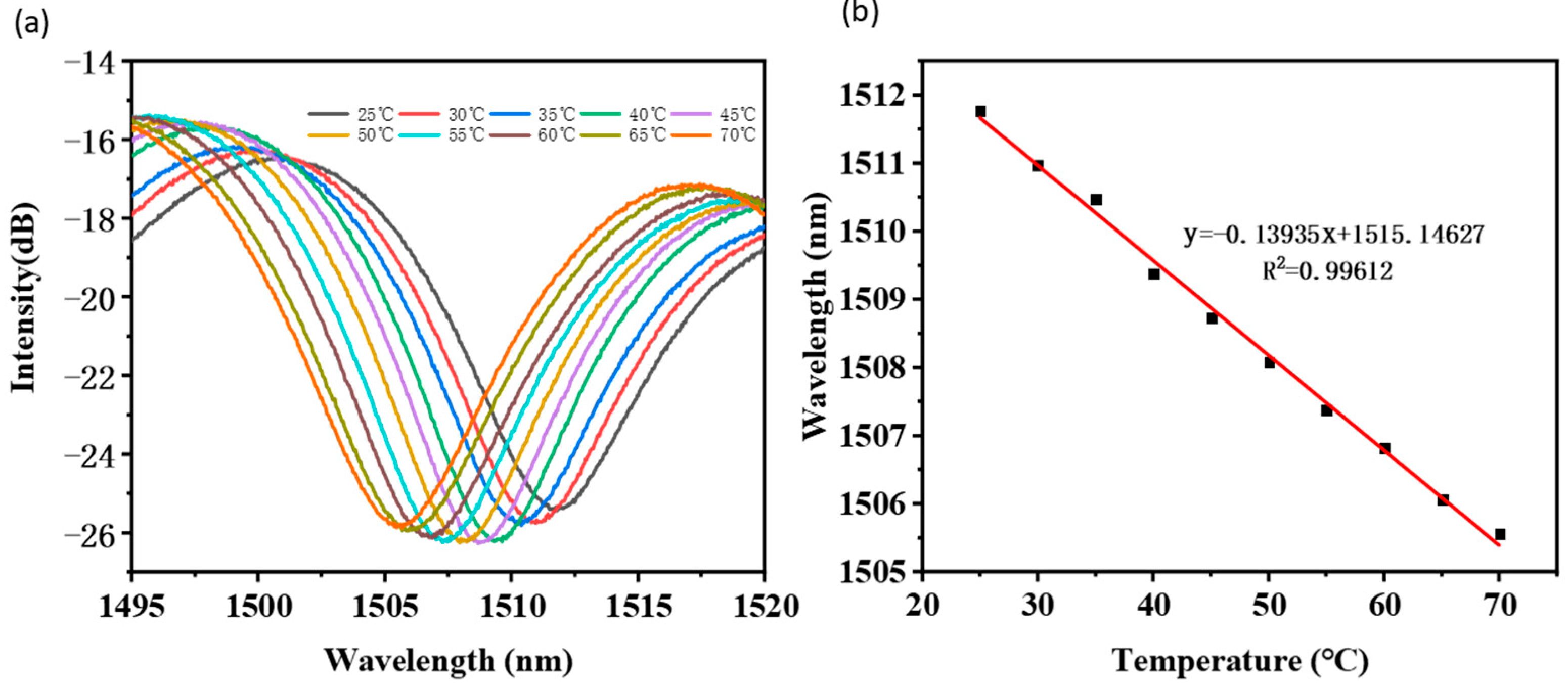
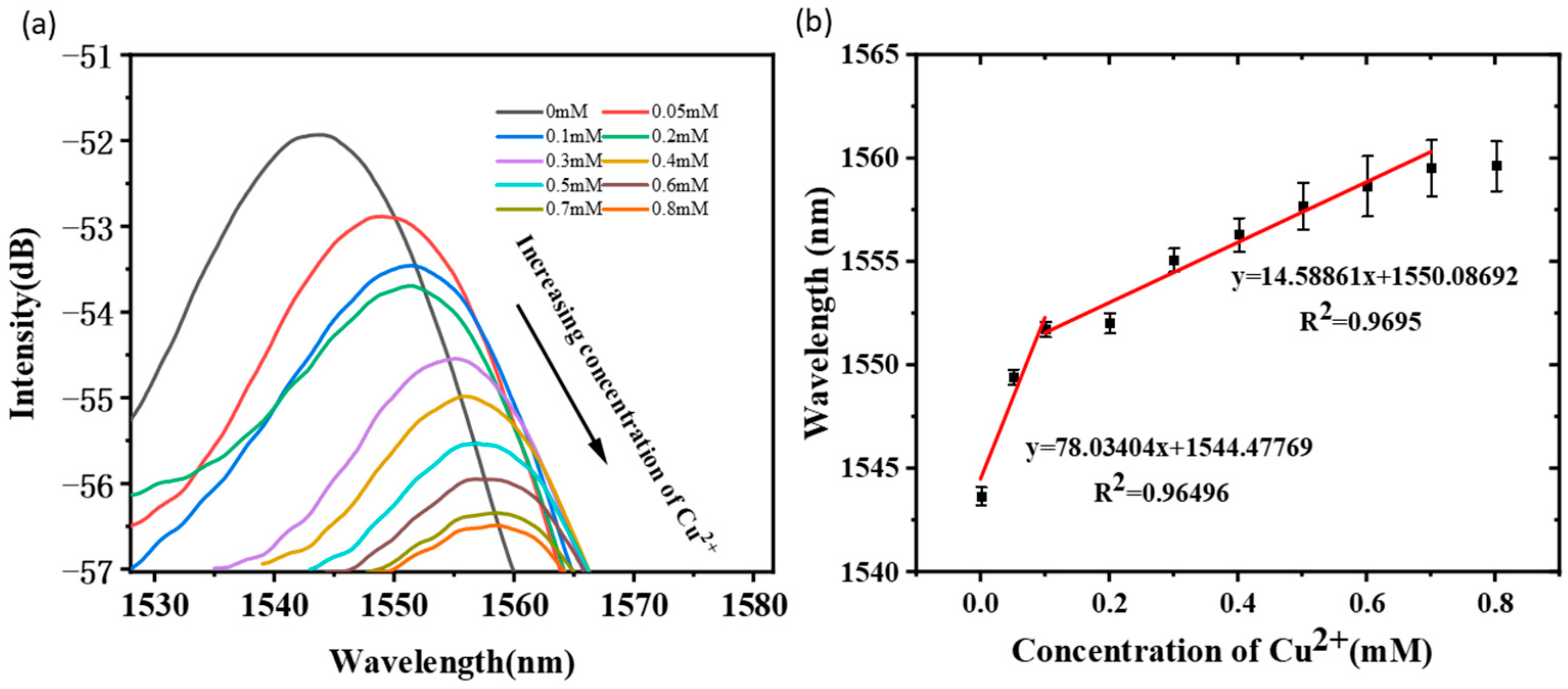
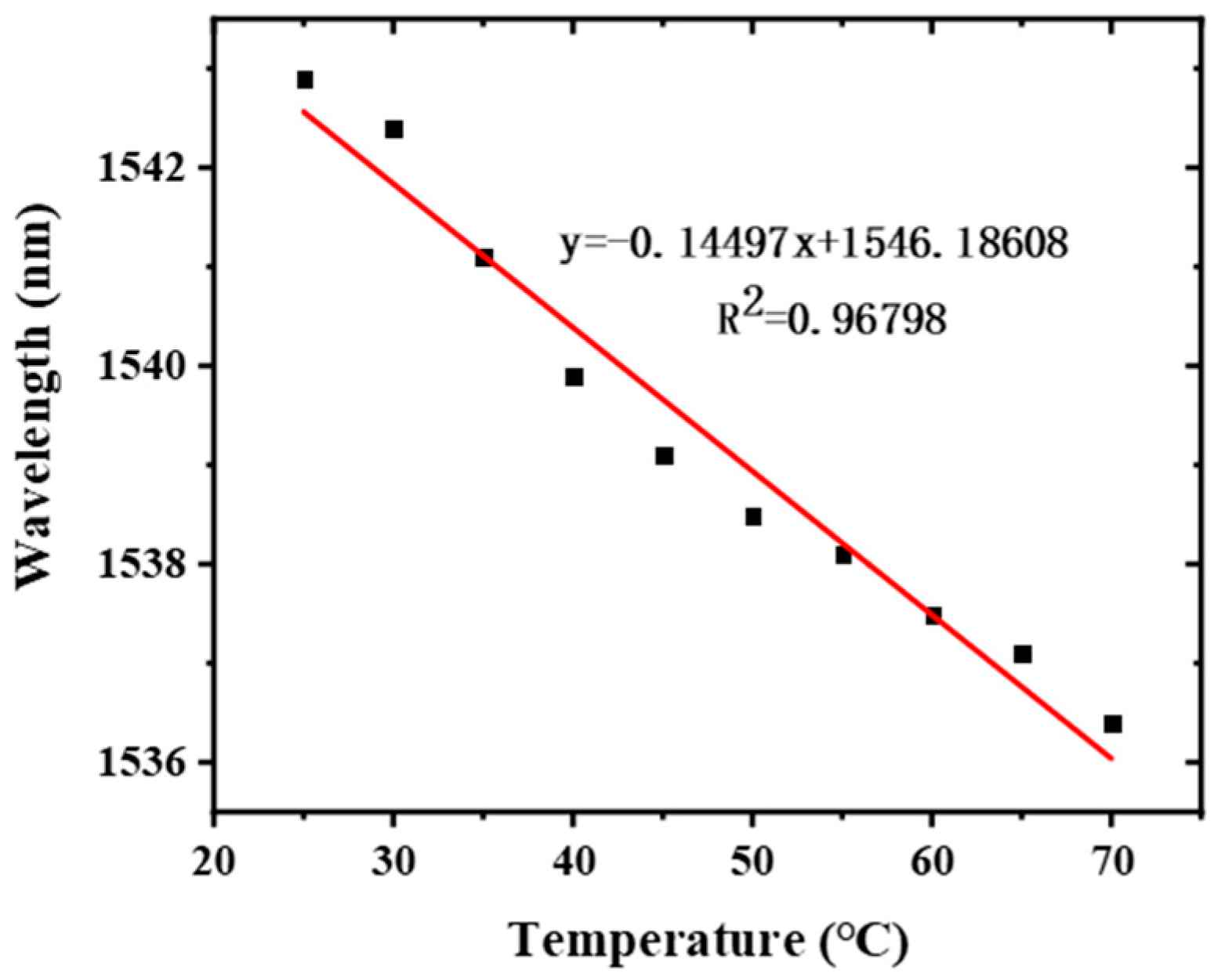
| Sensor No. | Diameter of the First Taper Waist (μm) | Diameter of the Second Taper Waist (μm) | Second Taper Length (μm) | Second Taper Waist Length (μm) | Second Taper Ratio | Sensor Total Length (μm) |
|---|---|---|---|---|---|---|
| a-1 | 30 | 20 | 600 | 2000 | 0.3 | 6600 |
| a-2 | 40 | 20 | 600 | 2000 | 0.3 | 6600 |
| a-3 | 50 | 20 | 600 | 2000 | 0.3 | 6600 |
| a-4 | 60 | 20 | 600 | 2000 | 0.3 | 6600 |
| b-1 | 40 | 20 | 600 | 2000 | 0.3 | 6600 |
| b-2 | 40 | 25 | 600 | 2000 | 0.3 | 6600 |
| b-3 | 40 | 30 | 600 | 2000 | 0.3 | 6600 |
| b-4 | 40 | 35 | 600 | 2000 | 0.3 | 6600 |
| Sensor No. | Diameter of the First Taper Waist (μm) | Diameter of the Second Taper Waist (μm) | Second Taper Length (μm) | Second Taper Waist Length (μm) | Second Taper Ratio | Sensor Length (μm) |
|---|---|---|---|---|---|---|
| c-1 | 40 | 20 | 600 | 2000 | 0.3 | 6600 |
| c-2 | 40 | 20 | 700 | 2000 | 0.35 | 6700 |
| c-3 | 40 | 20 | 800 | 2000 | 0.4 | 6800 |
| c-4 | 40 | 20 | 900 | 2000 | 0.45 | 6900 |
| c-5 | 40 | 20 | 1000 | 2000 | 0.5 | 7000 |
Publisher’s Note: MDPI stays neutral with regard to jurisdictional claims in published maps and institutional affiliations. |
© 2022 by the authors. Licensee MDPI, Basel, Switzerland. This article is an open access article distributed under the terms and conditions of the Creative Commons Attribution (CC BY) license (https://creativecommons.org/licenses/by/4.0/).
Share and Cite
Gong, Z.; Lei, Y.; Wang, Z.; Zhang, J.; Sun, Z.; Li, Y.; Huang, J.; Chan, C.; Ouyang, X. A Taper-in-Taper Structured Interferometric Optical Fiber Sensor for Cu2+ ion Detection. Sensors 2022, 22, 2709. https://doi.org/10.3390/s22072709
Gong Z, Lei Y, Wang Z, Zhang J, Sun Z, Li Y, Huang J, Chan C, Ouyang X. A Taper-in-Taper Structured Interferometric Optical Fiber Sensor for Cu2+ ion Detection. Sensors. 2022; 22(7):2709. https://doi.org/10.3390/s22072709
Chicago/Turabian StyleGong, Zidan, Yisong Lei, Ziwen Wang, Jie Zhang, Zeji Sun, Yuyao Li, Jianhao Huang, Chichiu Chan, and Xia Ouyang. 2022. "A Taper-in-Taper Structured Interferometric Optical Fiber Sensor for Cu2+ ion Detection" Sensors 22, no. 7: 2709. https://doi.org/10.3390/s22072709
APA StyleGong, Z., Lei, Y., Wang, Z., Zhang, J., Sun, Z., Li, Y., Huang, J., Chan, C., & Ouyang, X. (2022). A Taper-in-Taper Structured Interferometric Optical Fiber Sensor for Cu2+ ion Detection. Sensors, 22(7), 2709. https://doi.org/10.3390/s22072709






